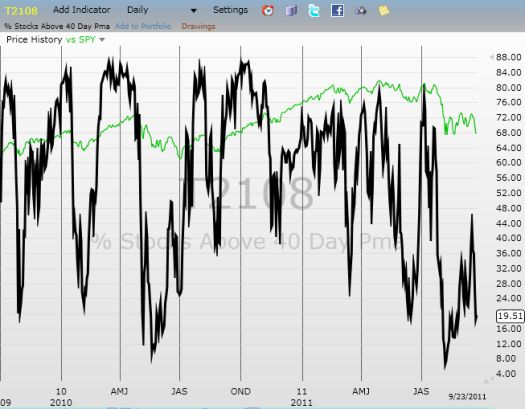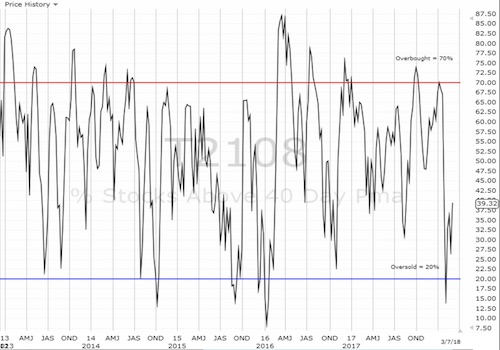(T2108 measures the percentage of stocks trading above their respective 40-day moving averages [DMAs]. To learn more about it, see my T2108 Resource Page. You can follow real-time T2108 commentary on twitter using the #T2108 hashtag.)
T2108 Status: 33%
VIX Status: 32
General (Short-term) Trading Call: Hold (see below for more details).
Commentary
T2108 had another good day, gaining three percentage points to 33%. The gains in the S&P 500 were once again very mild. After gaining as much as 1.3%, the index ended the day with a small 0.5% gain. The VIX remains stubborn: it only dropped another 4% and still appears ready to rally higher again. The VXX remains as elevated as ever (click links for current charts). With the stochastics even more stretched, the index looks primed for a setback for at least a day or two. I realize this completely contradicts my gut sense that the first day of trading for September will deliver a large one-day rally. Perhaps if we do get the sell-off, the big day will come post-Labor Day.
The S&P 500 stopped 1.8% short of the next line of resistance at the 50DMA. The strong pullback is no surprise given the stochastics are overbought. As I said yesterday, “If you are a daytrader, it will make a lot of sense to try shorting into any intraday rally for the next day or two.” I went ahead and purchased some SDS, the Proshares UltraShort S&P500 as a small hedge against my bullish positions. The clincher for me was noticing the overnight and recent strength in the Swiss franc and Japanese yen. In particular, the franc gained over 1.5% over the U.S. dollar, so I could not imagine a lasting intraday rally with the currency markets expressing “fear.” This experience reminded me that it may be even more important to watch currency trends as the market treads carefully over all the perceived risks in the market. (If you find yourself saying the “market climbs a wall of worry”, pinch yourself twice. When you wake up, jot down reasons why the market refused to climb this magical wall for almost three weeks in August).
I leave you with this very brief commentary from Nightly Business Report where Jerry Lin asks whether computers are to blame for the recent volatility in the market. He provides a sobering statistic: about 70% of all trades on the NYSE are algorithmic. The needs of all these machines are so large that they are sucking up tremendous amounts of technical talent away from high-tech industries and into financial firms. If this sounds familiar, it should. For much of the previous decade, many of the nation’s brightest minds in mathematics, physics, etc… flocked to trading firms in pursuit of riches. It seems we have our post-panic, post-Recession deja vu version with the high frequency traders (HFTs) and trading robots. If there was ever a need for mere mortal humans to approach this endeavor with simple rules ready for near automatic execution, this is it!
Watch the full episode. See more Nightly Business Report.
Charts below are the latest snapshots of T2108 (and the S&P 500)
Refresh browser if the charts are the same as the last T2108 update.
Daily T2108 vs the S&P 500

Black line: T2108 (measured on the right); Red line: S&P 500 (for comparative purposes)
Weekly T2108

*All charts created using TeleChart:

Related links:
The T2108 Resource Page
Expanded daily chart of T2108 versus the S&P 500
Expanded weekly chart of T2108
Be careful out there!
Full disclosure: long shares and calls on SSO, long VXX puts, long SDS, net long Swiss franc, short Japanese yen
